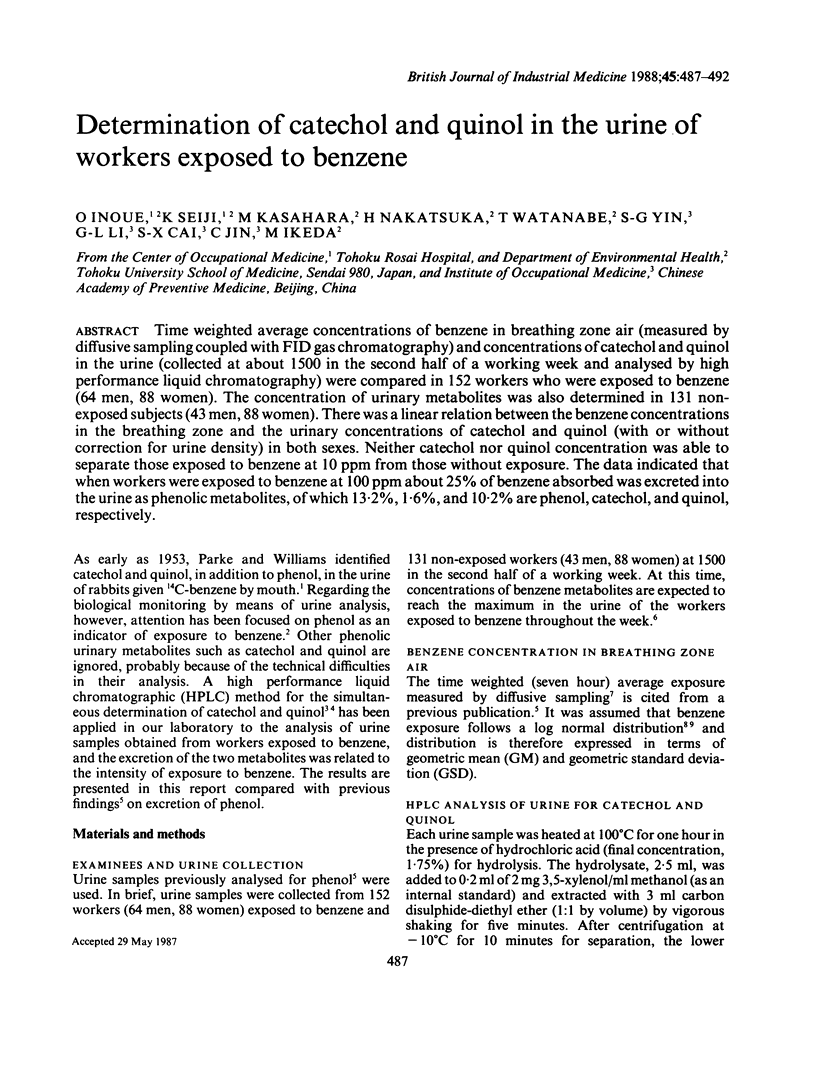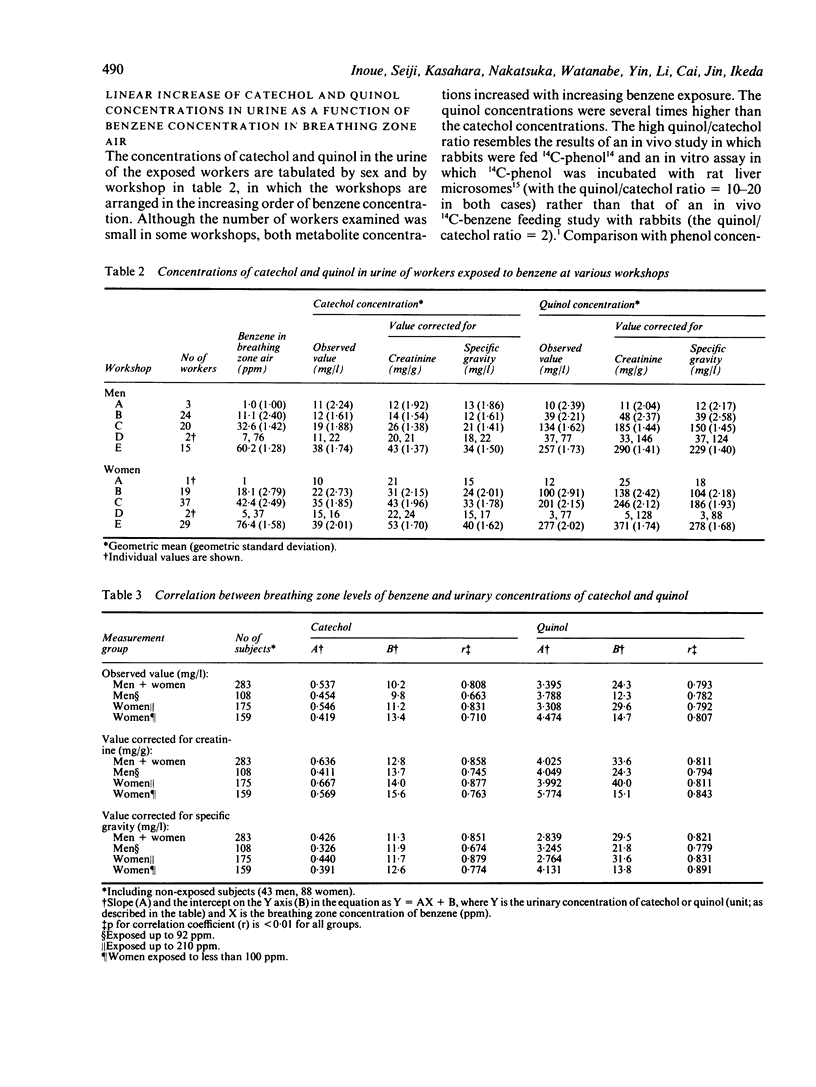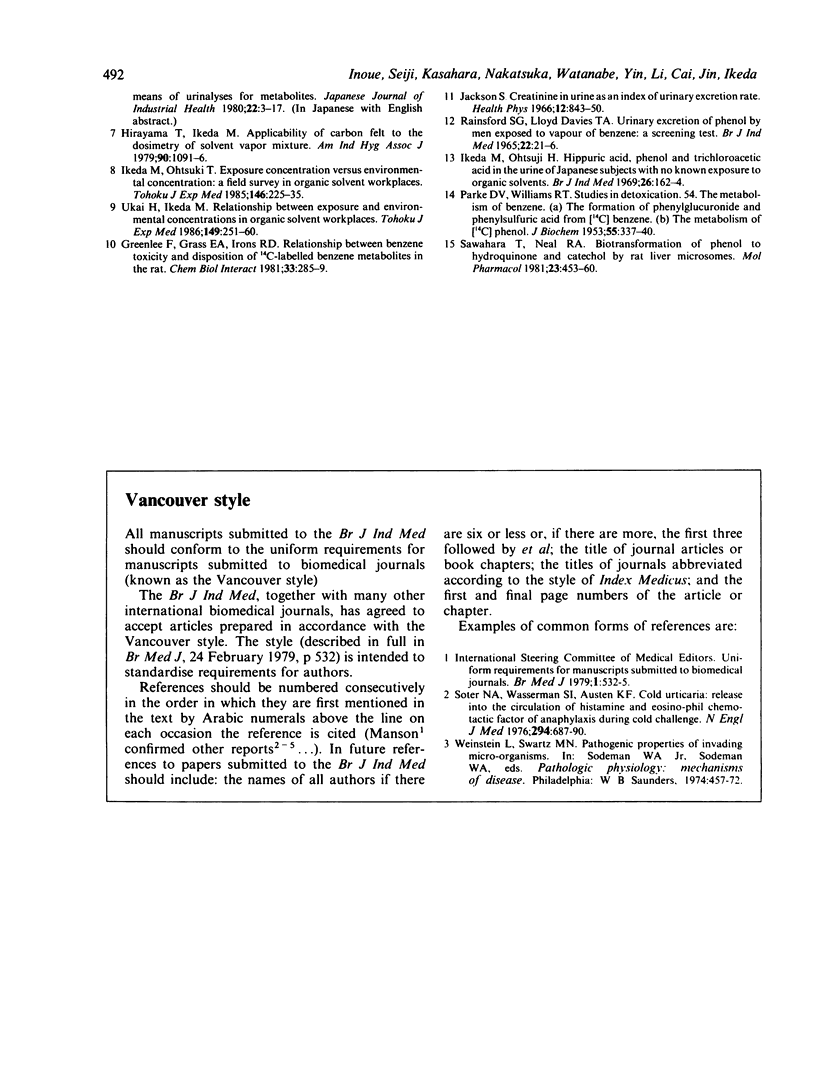Abstract
Time weighted average concentrations of benzene in breathing zone air (measured by diffusive sampling coupled with FID gas chromatography) and concentrations of catechol and quinol in the urine (collected at about 1500 in the second half of a working week and analysed by high performance liquid chromatography) were compared in 152 workers who were exposed to benzene (64 men, 88 women). The concentration of urinary metabolites was also determined in 131 non-exposed subjects (43 men, 88 women). There was a linear relation between the benzene concentrations in the breathing zone and the urinary concentrations of catechol and quinol (with or without correction for urine density) in both sexes. Neither catechol nor quinol concentration was able to separate those exposed to benzene at 10 ppm from those without exposure. The data indicated that when workers were exposed to benzene at 100 ppm about 25% of benzene absorbed was excreted into the urine as phenolic metabolites, of which 13.2%, 1.6%, and 10.2% are phenol, catechol, and quinol, respectively.
Full text
PDF





Selected References
These references are in PubMed. This may not be the complete list of references from this article.
- Andrews L. S., Sasame H. A., Gillette J. R. 3H-Benzene metabolism in rabbit bone marrow. Life Sci. 1979 Aug 13;25(7):567–572. doi: 10.1016/0024-3205(79)90550-2. [DOI] [PubMed] [Google Scholar]
- Hirayama T., Ikeda M. Applicability of activated carbon felt to the dosimetry of solvent vapor mixture. Am Ind Hyg Assoc J. 1979 Dec;40(12):1091–1096. doi: 10.1080/15298667991430749. [DOI] [PubMed] [Google Scholar]
- Ikeda M., Hara I. [Evaluation of the exposure to organic solvents by means of urinalysis for metabolites (author's transl)]. Sangyo Igaku. 1980 Jan;22(1):3–17. doi: 10.1539/joh1959.22.3. [DOI] [PubMed] [Google Scholar]
- Ikeda M., Ohtsuji H. Hippuric acid, phenol, and trichloroacetic acid levels in the urine of Japanese subjects with no known exposure to organic solvents. Br J Ind Med. 1969 Apr;26(2):162–164. doi: 10.1136/oem.26.2.162. [DOI] [PMC free article] [PubMed] [Google Scholar]
- Ikeda M., Ohtsuki T. Exposure concentration versus environmental concentration: a field survey in organic solvent workplaces. Tohoku J Exp Med. 1985 Jun;146(2):225–235. doi: 10.1620/tjem.146.225. [DOI] [PubMed] [Google Scholar]
- Inoue O., Seiji K., Kasahara M., Nakatsuka H., Watanabe T., Yin S. G., Li G. L., Jin C., Cai S. X., Wang X. Z. Quantitative relation of urinary phenol levels to breathzone benzene concentrations: a factory survey. Br J Ind Med. 1986 Oct;43(10):692–697. doi: 10.1136/oem.43.10.692. [DOI] [PMC free article] [PubMed] [Google Scholar]
- Irons R. D., Dent J. G., Baker T. S., Rickert D. E. Benzene is metabolized and covalently bound in bone marrow in situ. Chem Biol Interact. 1980 May;30(2):241–245. doi: 10.1016/0009-2797(80)90130-1. [DOI] [PubMed] [Google Scholar]
- Jackson S. Creatinine in urine as an index of urinary excretion rate. Health Phys. 1966 Jun;12(6):843–850. doi: 10.1097/00004032-196606000-00014. [DOI] [PubMed] [Google Scholar]
- PARKE D. V., WILLIAMS R. T. Studies in detoxication. 54. The metabolism of benzene. (a) The formation of phenylglucuronide and phenylsulphuric acid from [14C]benzene. (b) The metabolism of [14C]phenol. Biochem J. 1953 Sep;55(2):337–340. doi: 10.1042/bj0550337. [DOI] [PMC free article] [PubMed] [Google Scholar]
- RAINSFORD S. G., DAVIES T. A. URINARY EXCRETION OF PHENOL BY MEN EXPOSED TO VAPOUR OF BENZENE: A SCREENING TEST. Br J Ind Med. 1965 Jan;22:21–26. doi: 10.1136/oem.22.1.21. [DOI] [PMC free article] [PubMed] [Google Scholar]
- Sawahata T., Neal R. A. Biotransformation of phenol to hydroquinone and catechol by rat liver microsomes. Mol Pharmacol. 1983 Mar;23(2):453–460. [PubMed] [Google Scholar]
- Soter N. A., Wasserman S. I., Austen K. F. Cold urticaria: release into the circulation of histamine and eosinophil chemotactic factor of anaphylaxis during cold challenge. N Engl J Med. 1976 Mar 25;294(13):687–690. doi: 10.1056/NEJM197603252941302. [DOI] [PubMed] [Google Scholar]
- Ukai H., Takada S., Inui S., Ikeda M. Relationship between exposure and environmental concentrations in organic solvent workplaces. Tohoku J Exp Med. 1986 Jul;149(3):251–260. doi: 10.1620/tjem.149.251. [DOI] [PubMed] [Google Scholar]


